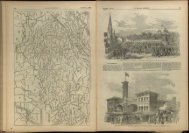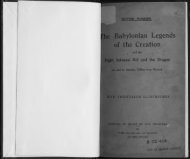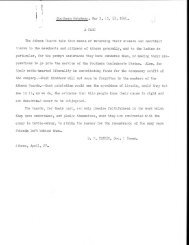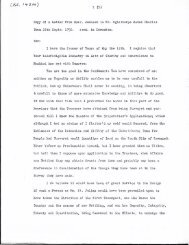I 23 CHRONOLOGICAL TABLE <strong>OF</strong> <strong>THE</strong> ODES. its being of the time of-king Yew) ; in Book v., the Seaou pican, the K'eaou yen, the Hojln sze, the Heang pill, the Kulifung. the Lull go, the Ta tung, and the &e yueli, the date of all of which is with Choo uncer tain; in Book vi., the Pill shan, the Wno tseang ta lien, the Seaou mlng, the .8*0 cliung, the Ts'flo £«'ze, the /Sm «a» shan, the fw tf'een, the Ta t'een, the Cften ^>e Loh e, and the Sliang-shang chay Ima, of all which Choo denies the assigned date, excepting in the case of the KPO cliung ; in Book vii., the Sang hoc. the Yuan yang, the Kweipecn, the Keu Tieah, the Ts'ing ying, the Pin che tsoo yen, the Tu ts'aou, the Ji'atf shuli, the A>oA &/«£, and the Yuh lew, hut of these Choo allows only the Pin che two yen to he capable of determinate reference to the time of Yew ; and in Book viii., the Tvojln sze, the Ts-ae lull, the Shoo meaou (referred by Choo to the time of king Seuen), the Sill sang, the Pill /two,, the 3Ieen man, the Hoc yell, the Ts-een tseen eke shift, the T'eami die hwa, and the Ho ts'aou.pall lavang, but Choo only agrees in assigning the Pill Jiiea and the Ho ts'aoupuh hnang to Yew's reign. In Part III., Book iii., two pieces;—the Chenjang and the Shaoti nuM. [xi.] Of the time of king P*ing In all 28 pieces, viz.— In Part I., 1 in Book iii.,—the LiiTi e ; 3 in Book v.,— the K~e yuh, the K'ami pman, and the Sliili jln, but Choo considers the date of the Raoupnan to be uncer tain; 6 in Book vi.,—the Shoo le, the Keun-txze yu y'ili, the Keun-ts-e yang-yang, the Yang che shn-uy, the Cluing laili yen t'uy, and the JLoh luy, of which Choo agrees in the assignment of one only, the Yang die slimuy ; 7 in Book vii.,—the Tsze e, the Tseaiig ehung- tsze, the Sltult yu t'een, the Ta slmli yu t'cen, the Kaou Ttfem, the Tsim ta loo, and the Neu yueli he ming, of which Choo allows the assignment of the Tsze e, the Shuk yu t'een, and the Ta sliuli yu t'een ; 7 in Book x.,— the Slum yem cJi'oo, the Yang cite shnuy, the Tseanw leaou, the Chmv mom, the Te too, the Kaou h'eiv, and the Paou yu, of which Choo agrees in the assignment only of the Yang die shieuy and the Tscaou leaon 4 in Book xi.,—the Sze t'eeli, the Seaou jung, the Keen Itea, and the Cliung nan, Choo allowing only the Sraowjimg. [xii.] In the reign of king P'iug, or king Hwau Seven pieces, all of Part I., Book ix., and all, accord ing to Choo, of uncertain date ;—the Koh ken, the Hivun tseu joo, the Yuen yem t'amt, the Chlh hoc, the Shlh mom die heen, the Fall fan, and the Sliih shoo. [xiii.] In the reign of king Hwau Thirty-two pieces, all of Part 1., viz.— 17 in Book iii. :—the Yen yen, the Jlh yueli, the Cliungfung} the Keih Two, the K'aefung, the Heung die, B.C. 769—719. 769—696. 718—G96. CHRONOLOGICAL TABLE <strong>OF</strong> <strong>THE</strong> ODES. yem Tt'oo yell, the Kuhfung, the Skill n'e, the > Maon k'erv, the Keen lie, the Ts'euen shwwy, the Pih mun, the Plhfung, the Tsing new, the Sin t'ae, and the Urh tsze thing clum, of which Choo allows only the date assigned to the Yen yen, the Jill yueli, the Ckung- I fung, and the Keili Two ; 4 in Book iv., — the Ts'eang yew tsze, the Keim-tsze lieae loon, the Sang divng, and the Shun die pun pun, in regard to all of which but the Sang cliung Choo coincides ; 5 in Book v., — the Mang, the CUuli kan, the Hman lan, the Pill lie, and the Yew Two, all ace. to Choo of uncertain date ; 3 in Book vi., — the T'oo yven, the Ts'ae koh, and the Ta hen, also of uncertain date with Choo ; 2 in Book vii., — the Yem nen t'ung lieu, and the Keen sliang, with him uncertain ; and 1 in Book xii., — the Moo mun, whose date Choo in the same way does not think can be determined. [xiv.] Of the time of king Chwang ... ... Fifteen pieces, all in Part I., viz. — 1 in Book vi., — the K'eiK cliung yem via, with Choo I uncertain ; 8 in Book vii., all with Choo uncertain, — the Shan yemfoo too, the T'oli he, the Kcami t'mig, the Fung, the Tung mun die shen, the Fung yv, the Tsze If ill, and the Yang die sliwuy ; and 6 in Book viii., the date and occasion of the 2nd and 3rd of which only are deemed uncertain by Choo. — the Nan shan, the Foo teen, the Loo ling, the Pe luito, the Tsae kmeu, aud the E tscay. [xv.] Of the time of king Le q j) ... Five pieces, all in Part I., viz. — 3 in Book vii., all with Choo uncertain, — the Cli'iih k-e L tung mun, the Yay yew man ts'aou, and the Ttin ivei ; 1 2 in Book x., the date assigned to the former of which I is admitted by Choo, the Woo e, and the Yem te che too [xvi.] Of the tune of king Hwuy ... ... Twelve pieces, all in Part I., viz. — 5 in Book iv., all admitted by Choo, — the Ting che I fattg cliimg, the Te tung, the Scang shoo, the Kan iitaou, and the Tgae di'e ; 1 in Book v., with Choo uncertain, I — the Muh laca ; 1 in Book vii., admitted by Choo, the 'iMi/ jin; 2 in Book x., with Choo uncertain, — the llStih sang and the Ts'ae ling ; 2 in Book xii., with Choo I uncertain, — the Fang yew ts'eoli ch'aov, and the Yueli I eh'uh ; and 1 in Book xiv., also with Choo uncertain, — [ the Fom yem. [xvii.] Of the time of king Seang ... ... In all thirteen pieces, of which 9 are in Part I., viz . — 1 in Book v., admitted by Choo, — the Ho Itirang ; 5 i in Book xi., of which Choo admits only the first and I fourth, — the Hmang neami, the Shin-fung, the Woo e, I the Wei yang, and the K'euen yu ; 3 in Book xiv., of 29 B.C. 695 — 681. 680—676. 676 — C31. 650—618.
so CHRONOLOGICAL TABLE <strong>OF</strong> <strong>THE</strong> ODES. which Choo accepts only the first,—the Hom-jin, the Slie-kew, and the Sea ts'euen. In Part IV., the 4 pieces of Book ii., in the occasion assigned for the first and last of which Choo agrees,— the Keuiig, the Yew peih, the P>van-s7nvuy, and the Pel Tiling. [xviii.] Of the tune of king Ting Two pieces in Part I., viz.— the Chou Hit, admitted by Choo, and the Tsih p'o in Book xii. B.C. 605—585. The editors of the imperial edition of the present dynasty say : " The dates of the composition of the odes it was found difficult to examine thoroughly after the fires of Ts'in, and so we find them variously assigned by the writers of the Han, T"ang, and other dynasties. " But the old Preface made its appearance along with the text of the Poems, and Maou, Ch'ing, and K'ung Ying-tah maintained and defended the dates assigned in it, to which there belongs what authority may be derived -from its antiquity. " When Choo He took the She in hand, the text of the poems was considered by him to afford the only evidence of their occasion and date, and where there was nothing decisive in it, and no evidence afforded by other classical Books, he pronounced these points uncertain ;—thus de ciding according to the exercise of his own reason on the several pieces. " Gow-yang Sew followed the introductory notices of Ch'ing, but dis puted and reasoned on the subject at the same time. Heu K'cen, and Lew Kin followed the authority of Choo, now and then slightly differing from him. " In the Ming dynasty appeared the ' Old meanings of the text of the She,' chronologically arranged by Ho K'eae, adducing abundance of testimonies, but with many erroneous views. We have in this work collected the old assignments of the Preface, supported by Maou, Ch'ing, and K'ung, and given due place to the decisions of Choo. The opinions of others we have preserved, but have not entered on any discussion of them." <strong>THE</strong> RHYME AND METEE <strong>OF</strong> <strong>THE</strong> PIECES. 81 CHAPTER III. | <strong>THE</strong> RHYME AND METRE OE <strong>THE</strong> PIECES; <strong>THE</strong>IR POET ICAL VALUE; PRINCIPLE ON WHICH <strong>THE</strong> PRESENT VERSION OE <strong>THE</strong>M HAS BEEN MADE; CERTAIN PECULIARITIES IN <strong>THE</strong>IR STRUCTURE. 1. I HAVE written at length on the Prosody of the Book of Poetry in my larger work. In this volume, in- lended for English readers, it is not necessary to say much about it. Rhyme has always been a characteristic of verse in China ; and all the earliest attempts at poetical composi tion were of the same form,—in lines con- Metre and sisting of four words, forming, from the Ehvme- nature of the language, four syllables. Wherever there is any marked deviation from this type, the genuineness of the piece as a relic of antiquity becomes liable to sus picion. This line of four words is the normal measure of the She, but it is not invariably adhered to. We have in one ode, according to the judgment of many native scholars, a line of only one word in each of its stanzas. Lines of two, of three, of five, of six, of seven, and even of eight characters, occasionally occur. When the poet once de parts from the normal law of the metre, he often con tinues his innovation for two or three more lines, and then relapses into the usual form. He is evidently aware of his deviation from that, and the stanzas where it takes place are in general found to be symmetrically constructed and balanced. 2. The pieces, as printed, appear divided into stanzas ; —and properly so, though the Han scholars say that such division was first made by Maou. Chang. He did his work well, guided mainly by the anzas' rhyme, and by the character of the piece as narrative, allusive, or metaphorical. In most pieces the stanzas are of uniform length, and








